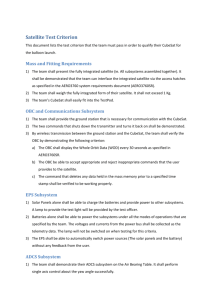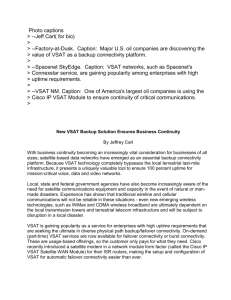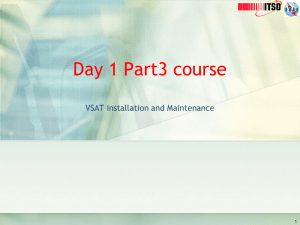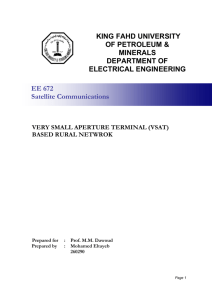EC702
advertisement
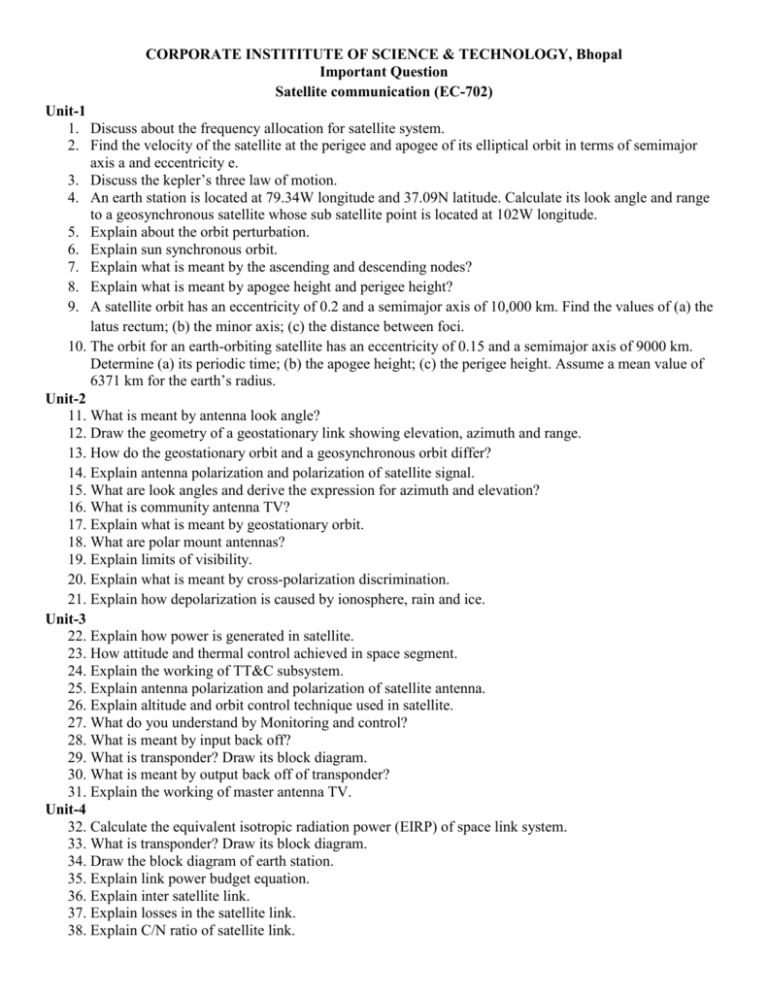
CORPORATE INSTITITUTE OF SCIENCE & TECHNOLOGY, Bhopal Important Question Satellite communication (EC-702) Unit-1 1. Discuss about the frequency allocation for satellite system. 2. Find the velocity of the satellite at the perigee and apogee of its elliptical orbit in terms of semimajor axis a and eccentricity e. 3. Discuss the kepler’s three law of motion. 4. An earth station is located at 79.34W longitude and 37.09N latitude. Calculate its look angle and range to a geosynchronous satellite whose sub satellite point is located at 102W longitude. 5. Explain about the orbit perturbation. 6. Explain sun synchronous orbit. 7. Explain what is meant by the ascending and descending nodes? 8. Explain what is meant by apogee height and perigee height? 9. A satellite orbit has an eccentricity of 0.2 and a semimajor axis of 10,000 km. Find the values of (a) the latus rectum; (b) the minor axis; (c) the distance between foci. 10. The orbit for an earth-orbiting satellite has an eccentricity of 0.15 and a semimajor axis of 9000 km. Determine (a) its periodic time; (b) the apogee height; (c) the perigee height. Assume a mean value of 6371 km for the earth’s radius. Unit-2 11. What is meant by antenna look angle? 12. Draw the geometry of a geostationary link showing elevation, azimuth and range. 13. How do the geostationary orbit and a geosynchronous orbit differ? 14. Explain antenna polarization and polarization of satellite signal. 15. What are look angles and derive the expression for azimuth and elevation? 16. What is community antenna TV? 17. Explain what is meant by geostationary orbit. 18. What are polar mount antennas? 19. Explain limits of visibility. 20. Explain what is meant by cross-polarization discrimination. 21. Explain how depolarization is caused by ionosphere, rain and ice. Unit-3 22. Explain how power is generated in satellite. 23. How attitude and thermal control achieved in space segment. 24. Explain the working of TT&C subsystem. 25. Explain antenna polarization and polarization of satellite antenna. 26. Explain altitude and orbit control technique used in satellite. 27. What do you understand by Monitoring and control? 28. What is meant by input back off? 29. What is transponder? Draw its block diagram. 30. What is meant by output back off of transponder? 31. Explain the working of master antenna TV. Unit-4 32. Calculate the equivalent isotropic radiation power (EIRP) of space link system. 33. What is transponder? Draw its block diagram. 34. Draw the block diagram of earth station. 35. Explain link power budget equation. 36. Explain inter satellite link. 37. Explain losses in the satellite link. 38. Explain C/N ratio of satellite link. 39. What is intermodulation noise and how it can be reduced. 40. Calculate CNR of combined uplink and downlink. 41. A satellite carrying a 9.8-GHz continuous-wave beacon transmitter is located in geosynchronous orbit 37,586 km from an earth station. The beacon’s output power is 0.3 W and feeds an antenna of 19-dB gain toward the earth station. The antenna is 3.65 m in diameter with an aperture efficiency of 62.5%. a) Calculate the satellite EIRP. b) Calculate the receiving antenna gain. c) Calculate the path loss. d) The earth station G/T. Unit-5 42. Give a brief overview of access control protocols. 43. Discuss the principle working of satellite radio broadcasting. 44. What is meant by interference between satellite circuits? 45. Explain error control in Digital DSB-TV. 46. What are the major elements that concern VSAT system design? 47. With the help of block diagram describe the operation of VSAT system. 48. Explain various application area of VSAT? 49. Write short note on: a) Lunch vehicle b) Spade 50. Write short note on: a) VSAT star network b) VSAT mesh network 51. With the help of block diagram explain the working of following: a) VSAT earth station b) Digital DBS TV




